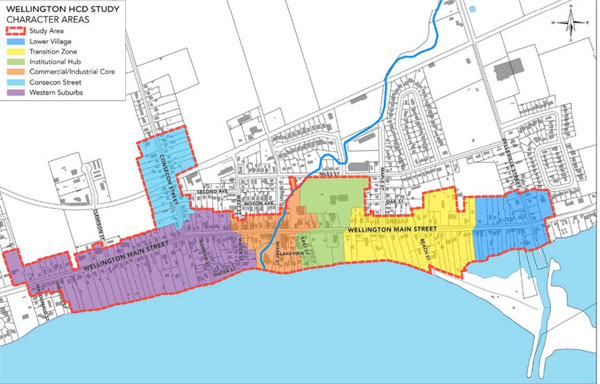Wellington heritage conservation district plan approved
Administrator | Sep 21, 2022 | Comments 1

A proposed heritage conservation district plan for the main corridor of Wellington was adopted at Tuesday’s council meeting, which had been recessed from the week before due to technical difficulties.
Approved is a revision of the draft of the final Heritage Conservation District (HCD) plan presented to council June 23, a meeting that received numerous councillor and public comments and concerns.
Comments and disagreement on several points continued at Tuesday evening’s meeting by several members of the public, where three deputations (from Richard Elliott, Anthony Lemke, and Mark Thompson Brandt of MTBA Associates Inc. representing Lemke and others), and two audience comments (from Lourdes DeCosta and Dan Leeming) were heard.
Anthony Lemke said he didn’t think there is sufficient enough room to breathe for the development objectives under the HCD.
“If you wanted to protect heritage in accordance with the terms of the HCD, you could do it in the Secondary Plan,” expressed Lemke. “You aren’t giving yourselves more powers tonight than you have already have.”
He stated that 240 properties included in the plan is the “most ambitious use of the HCD powers in all of Ontario on a per capita basis”.
“What you are doing is constraining yourself for those 240 properties, which is our entire village core, and part of the village corridor; you are constraining yourself to put the heritage guidelines
first – over and above all the other objectives in the Secondary Plan,” said Lemke.
“Let’s get this right, let’s press pause; I don’t think we’re there yet,” he added.
He noted that most contributing buildings are single family homes.
“What is not contributing is Foodland: to say that is not contributing is flat out wrong,” expressed Lemke. “Under the heritage guidelines, I can’t build today’s Foodland (at 10,000 square feet) downtown, I can’t build a larger pharmacy when we double the size of our town.”
“Let’s remove or refine characteristics; give us a bit more time to get it right, but don’t stop the process. Don’t vote yes tonight, press pause and give us another chance to get it right.”
The draft of the plan has been revised to reflect the feedback of the June meeting, including alleviating property right concerns, co-ordination with the secondary plan, proposed amendments focused on clarifying language associated with demolition, setbacks and height, and consideration for a mechanism for the proposal surrounding demolition.
Regarding property rights, it is noted the heritage conservation district plan remains consistent in that it will not infringe on property rights.
“A property owner may continue to use their property for the desired purpose relative to the zoning bylaw,” said Michael Michaud, director of planning. “However, the HCD plan could place extra scrutiny on the property, particularly if the property is deemed to be contributing to the heritage value as expressed within the plan.”
It is noted that most maintenance work and construction does not require any heritage permit or evaluation, but property owners are best to consult the plan and or the municipality’s planning department to determine what may or may not require a heritage permit.
Lourdes DaCosta’s concerns relate to the consultation process.
“Considering how restrictive the plan is, it overrides the limits and rights of property owners,“ said DaCosta. “The owners of those properties were really excluded from any early discussions when the plan was initially developed.”
She also had issue with the scope of the plan.
“Given its restrictive nature, it is overly inclusive; heritage properties have certain physical characteristics that warrant preservation,” she said. “There hasn’t really been a real conversation whether and why each of the 240 properties have heritage characteristics that warrant preservation.”
It was also deemed that greater clarity was required about the plan not being compulsory, so wording has been added to read: “Adherence to the guidelines is not compulsory…”.
Other terminology included the removal of proposed development needing “to be consistent with” the guidelines.
“It was thought that this terminology would place an undue burden on the developer and as such, wording has changed to “having regard for” the guidelines which is viewed as being more accommodating.”
It was suggested adjusting the character areas to deal with potential densification and additional height, where it was noted that the character areas do not direct land use and that they provide a framework to guide development within that particular area of the HCD plan.
“Changing the boundaries of the character areas now would require that the HCD study, already approved, be opened up once again and reviewed and approved based on new potential boundaries,” noted Michaud in his report.
The HCD plan has been adjusted to refer to the locations within the secondary plan that can be considered for greater height.
Michaud further clarified that the Heritage Conservation District plan and the Secondary Plan work hand-in-hand.
“One is to support the other,” said Michaud. “The HCD does talk about having design guidelines for a small section of the village, or it could be the entire village, and one could think of the HCD being design guidelines for a component of a higher standard of design or development needs to take place when development is contemplated on a piece of property.”
The revised HCD plan also proposes new language for the potential demolition of a building within the plan.
“The original wording proposed limited reasoning (i.e. neglect, hazardous building condition, etc.) why a building should be demolished,” explained Michaud. “The proposed new wording provides a more defined approach toward demolition.”
The requirement for a professional engineer report to support the demolition based on building condition and a Heritage Impact Assessment report providing rationale for why the structure should be demolished is needed. Effectively, the property owner will need to demonstrate to the satisfaction of council, why a building should be demolished.
Michaud noted that concerns were also raised regarding proposed additions so wording has been added that additions should be stepped back from the main building.
“The use of the word “should” should provide flexibility in design and reasoning for supporting approval of a design that is not stepped back if the addition is felt required and or in keeping with the heritage values of the plan.”
Michaud noted the original wording used ‘shall be consistent with’ has been changed to ‘should’, instead of ‘shall’, and ‘have regard to’.
“It is a lesser level of detail or requirement for development, so we have provided greater flexibility for the landowners who want to develop in this area,” Michaud explained.
“There no longer needs to be if you are next to a three-storey building, you need to be at three-storeys,” he said. “It has to be very similar to the scale and character of what’s beside you, it does speaks to being more consistent with and the language used in Secondary Plan; the HCD wording now is a a little bit less restrictive.”
Councillor Ernie Margetson said, “the goal of the HCD should not be just to stunt the possibility of the commercial area to evolve, but to have a goal of conserving the heritage attributes as change takes place.”
“The goal is to allow properties to evolve,” confirmed Michaud.
 Margetson further noted that redevelopment scenarios in commercial areas could be entertained providing they do the necessary work and get the approvals.
Margetson further noted that redevelopment scenarios in commercial areas could be entertained providing they do the necessary work and get the approvals.
Richard Elliott said while he supports the concept of a heritage district, he had issues with some remaining challenges in the plan itself, noting he is “just looking to get it right.”
“It is the specific plan, the scope of it, the restrictiveness of the language, and maybe some unintended consequences,” said Elliott.
While he knew the plan would cover a number of buildings, he said, “I didn’t anticipate it would cover 240 buildings; more buildings than Niagara-on-the-Lake, which has 10 times the population.”
In order for the plan to be adopted, a bylaw will have to be passed in accordance with the requirements of the Ontario Heritage Act. The public will have 30 days from the publication of the bylaw to appeal the decision, and if no appeals are received, the plan will become effective.
The long process began in 2011, with a heritage conservation designation study being undertaken in July 2019 by consulting firm Bray Heritage, along with subsequent public consultation on Nov. 24, 2021 and May 5, 2022.
The background story can be found by clicking here.
The Wellington Heritage Conservation District project had an initial budget of approximately $75,000 which has been slightly exceeded in order to accommodate extra meetings required to respond to public concerns and avoid an appeal.
Wellington is the second area of Prince Edward County to receive a heritage conservation district designation. Picton received the designation in July 2013.
In his report, Michaud noted local support for the HCD comes from the Wellington and District Business Association and the Prince Edward Heritage Advisory Committee.
Michaud noted that based on comments received there is general support for heritage district designation.
There are more than 100 heritage conservation districts in Ontario.
“HCDs are essentially an expression of what local residents want to conserve,” said Michaud. “Studies have revealed that property owners have a high degree of satisfaction with the effect of designation on their property values and economic development within the district.”
In practice, an HCD is a tool used by communities to help manage change in ways that conserve and enhance those aspects of a place that local people most value, the report stated.
“An HCD plan encourages development, but of a compatible kind.”
While consideration was given to potentially delaying completion of the HCD plan to allow more time for public consultation, it was considered ample consultation in terms of number of meetings and responses to emails and phone calls, was adequate.
It was also deemed time is of the essence.
“Planning for development of the parcels north of the Millennium Trail is well underway and critical decisions are pending for such matters as road and sewer upgrades,” stated Michaud. “These upgrades could have a direct impact on the heritage attributes of the proposed district unless the policies and guidelines in the HCD plan are in place.”
Filed Under: Local News
About the Author:
































And not a moment too late, as development pressure on Wellington increases. Next step: an HCD designation for Main Street Bloomfield, before development pressures drastically change what is still intact.